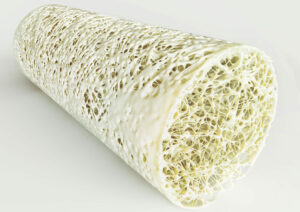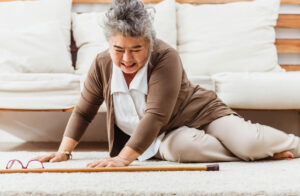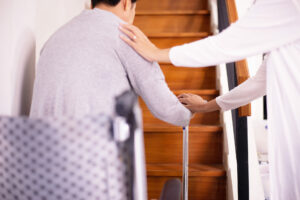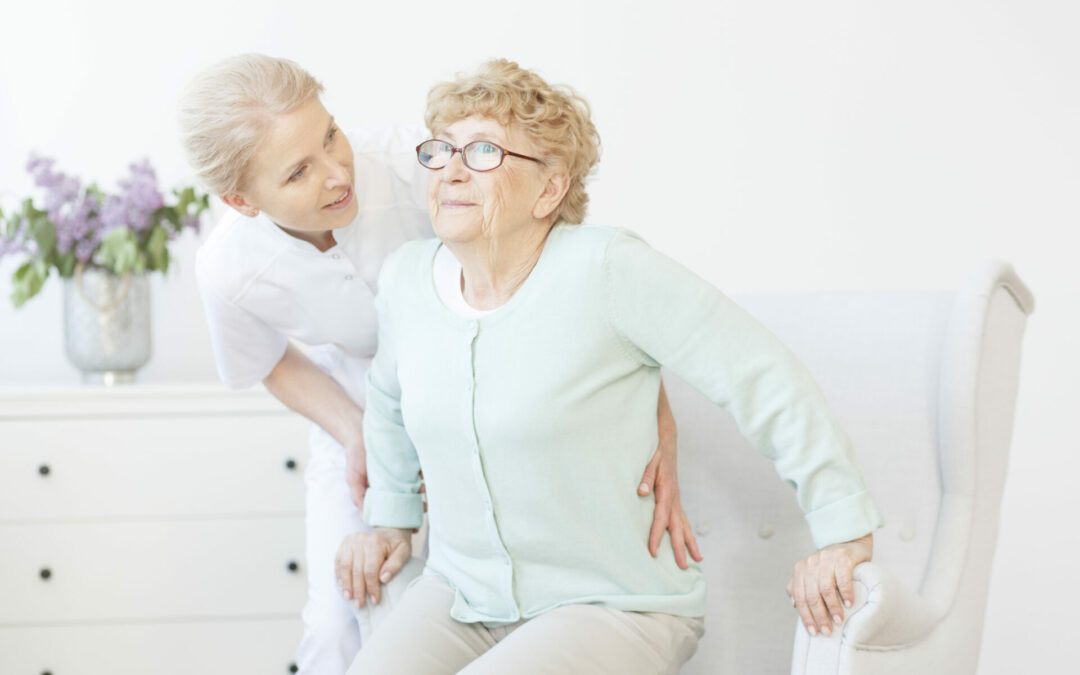One in Four elderly people experience at least one fall each year. Many of these falls result in serious injury, including at least 32,000 deaths each year., including broken bones. For our elderly loved ones, finding ways to reduce the risk of falls is an important part of their care.
Despite your best efforts, there may come a time when a loved one with osteoporosis falls. While you can’t prevent every fall, there are some steps you can take to reduce the risk of falls and injuries. Seniors with osteoporosis are at a higher risk of falls, which can result in serious injury. Fortunately, there are steps that family caregivers can take to help reduce this risk.With our tips, you can help your loved one avoid those hazardous falls and stay safe.
Contents
Reduce The Risk Of Falls In Seniors: Elderly With Osteoporosis
Reduce the risk of falls in the elderly when there is osteoporosis. The condition entails bone weakness and brittleness. Falling in general results in fractures. Older adults often don’t do well with injuries such as bone cracks. So that is why fall prevention is very important in the case of having this bone disease.
Osteoporosis or bone brittleness has negative effects on bone mass and density. Young, middle-aged, and old people can avoid having this. But those suffering from it need support to stay strong and in doing certain tasks. Also, measures for preventing falls elderly can manage must be there.
Geriatric patients are more prone to accidents because of their physical disabilities. In the case of bone loss, the issue can make matters worse since it affects comfort, posture, and mobility. Thus it is something that needs immediate action even though it is irreversible. Without treatment, it becomes worse.
Why It’s Vital To Face Osteoporosis and Reduce The Risk Of Falls
When older adults have bone fractures, they don’t only experience pains. They also lose some of their functionality. Thus they can also become deprived of their independence. Facing these troubles may start negative feelings such as self-loathing, anxiety, and depression. For that reason, there is a need to know what prevents osteoporosis and falls. But dealing with the disease and incidences of elderly falls is also as important.

Besides, aside from causing injuries, elderly falls can also bring about financial burdens. Bear in mind that seniors either have reduced or no income. So, for their health issues, they would need others for help. This means that loved ones may have to shoulder the expenses.
It does become worse when left untreated and is uncurable. Yet there are ways to slow its progression. With the right measures, quality of life is still achievable.
Ways To Address The Disease And Reduce The Risk Of Falls
It is important to understand bone loss and know how to reduce the risk of falling. Find out what prevents osteoporosis, how it happens, and the ways to deal with it. Think about the nature of why old people keep falling while having the disease. With these things in mind, it would be convenient to manage cases of elders with bone brittleness.
Understanding Osteoporosis
Folks who suffer from this condition have fractures due to having fragile bones. Science discovered several reasons behind the occurrence of bone fragility. Knowing its nature can aid in its prevention and in providing supportive care.

The point is that calcium is the mineral that makes bones flexible, hard, and strong. Vitamin D helps in letting the body absorb it. Being active compels the body to improve its bone flexibility, hardness, and strength. Thus a deficiency in calcium and vitamin D can cause the problem. A sedentary lifestyle often leads to bone weakness too.
Prevention and Treatment of Osteoporosis
These things can help a lot to reduce the risk of falls. So try to find out how to stop or at least do something about this health condition in the elderly. Think about calcium, vitamin D, and activity for these things.
Calcium
Poor calcium intake may be from not having access to the mineral or taking only a few of it for a long time. Eating disorders and gastrointestinal operations may affect calcium absorption too. Having regular doses of calcium supplements may help. Consuming calcium-rich items like dairy, yogurt, edamame, and almonds may be helpful too.

Vitamin D
For better calcium absorption with vitamin D, daily sunlight exposure helps a lot. Elders can get this from having routine morning walks. Besides, walking helps in being active and thus developing more bone cells. It’s that or eating vitamin D fish sources like salmon, tuna, and sardines that will work.
Bisphosphonates
These are drugs that help slow the loss of bone mass. Doctors prescribe them to patients with signs of bone weakness or osteoporosis. Examples of these are as follows.
- Zoledronic Acid
- Alendronate
- Ibandronate
- Etidronate
- Risedronate
Yet there are some precautions to consider before intake. For instance, only water should go with bisphosphonates. This might not be for people with allergies to them, kidney problems, and low calcium levels.
Phosphorus
Bone minerals have in them calcium phosphate. So it is clear that the body needs it for better bones too. With it, bone formation gets better. Sources of this are seafood, legumes, poultry, dairy products, and red meat. For vegans, nuts and seeds have them.
Understanding and Reducing the Risk of Falls
It’s not only important to reduce the risk of osteoporosis or handle it. Knowing why people collapse because of it is critical too. That’s because, in dealing with the disease, acting on what it can cause can help a lot. Such may aid in maintaining safety and improving quality of life. So we ought to discover how osteoporosis makes elders slip or tumble.
People lose their balance, hit the ground, and sustain injuries when they fall. Bone fragility may result in bad head, shoulder, spine, wrist, knee, and ankle injuries. Studies show that seniors experience balance and strength issues from bone issues. Such things cause muscle weakness, hunchback, and problems controlling movement.
How To Reduce The Risk Of Falling In Elderly Loved Ones
When it comes to this subject, it’s not enough to reduce the risk of falls by addressing osteoporosis. After all, mishaps can happen at any time. So it makes sense to take steps to help older adults manage daily living while being at risk of falling. We can say that we must do things to stop accidents before they happen.

Below are precautions for when geriatric patients would collapse. These include steps in preventing falls elderly can take part in. Also, included are tips to care for seniors better indoors and outdoors.
Means To Reduce The Risk Of Falls Outdoor
- Elders need to wear the right shoes for walking. This means putting on a pair with low heels and great traction. But it would be wise to avoid walking in steep and slippery areas too.
- Travel only in good weather, as much as possible. Intense heat from warm weather may cause blurred vision. People can lose their balance when they step on something they didn’t see. Heavy moisture from rains and snow may cause sidewalks to turn slippery too. Walking on grassy areas for better traction may help.
- Walking without holding anything may prevent falls elderly can get used to. This is to make the hands free and ready at any time to grab onto something in the event of falling. Using a cane or any assistive device for balance works in the same way.
- Passing by areas with great lighting helps a lot. With this, seniors may see their paths better and won’t have the misfortune of tumbling down.
Safety Tips To Prevent Elderly Collapse Indoor
- Change the rooms, stairs, and floors to reduce the risk of falls. This means installing better lighting equipment, grab bars, and non-slip floor mats. But, of course, this also means rearranging things. Free areas of clutter and make objects visible and accessible to older adults.
- Put markings on different areas of the house. This will help seniors identify better which rooms they are in. With these, they could estimate distances too. It means such things could help old people gauge the effort they need to exert.
- Be mindful of their medication. Make sure that geriatric patients only have those for relaxation in the bedroom. It’s the same for the drugs to control high blood pressure. Also, instruct them to take these while sitting on the bed. That is so they won’t have to ambulate anymore while feeling drowsy.
- Always have assistive devices nearby. Conditions like osteoporosis in the elderly progress so people who have it need help. It would be best to have mobility aids to always have objects for balance and movement.
Can you Successfully Reduce the Risk of Falls in Elderly Loved Ones?
To reduce the risk of falls in older adults, we must address what causes them. One of what leads to old people collapsing is the loss of bone density, strength, and flexibility. With the weakness of bone minerals, people become prone to accidents and injuries. With extra caution, we can help our senior parents reduce the risk of falls and enable them to live a healthier life.
It means getting enough nutrients to support bone maintenance. Also, it involves being cautious while doing daily activities of living. These are essential because the condition has no cure and progresses. With them, life may still be enjoyable for seniors.
Falls are a major cause of injury and death in seniors, but there are many things we can do to help reduce the risk. Ensuring good nutrition, providing a safe environment, and being cautious can all go a long way in preventing falls. Please leave your comments and questions below so that we can continue the discussion on how to keep our elderly loved ones safe.
Read More
Things To Do When An Elderly Parent Keeps Falling
Different Ways For Seniors To Keep The Brain Healthy





